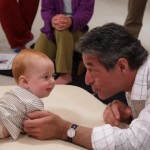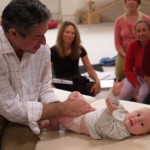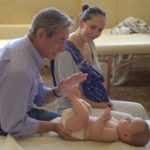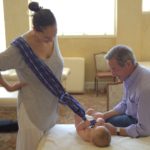Benjamin Shield, Ph.D.
Pediatric Craniosacral Therapy
The treatment of infants and children is one of the most important aspects of health care. Pediatric Craniosacral Therapy is foundational to this care. For decades, the treatment of infants and children was relegated behind that of adults. In recent times, practitioners of Pediatric Craniosacral Therapy have proved the importance of this work and have refined its theory and technique.
Why is it so essential to treat children? An osteopath recently answered this question with this simple statement: “When we look at a child, we never know who or what that child can be. And when we look at an adult, we never know who or what that individual could have been.”
Life has its challenges, and there may be few challenges more significant than the birth process itself. Every birth has its story, and even what may appear to be the simplest of births may create significant lifelong impacts on both the child and family.
This is true, as well, for the stages of childhood. Pediatric Craniosacral Therapy utilizes simple and effective therapeutic techniques to help normalize the child’s structure, balance the nervous system, and resolve traumatic issues of the birth and childhood experience.
Dr. William Sutherland, the founder of Cranial Osteopathy, had a favorite saying. To paraphrase, “As the twig is bent, so grows the tree.” An injury, whether seemingly minor or alarmingly significant, has the potential to impact an individual for his or her entire life.
If we can treat an individual early in life, we can prevent or resolve many conditions that can detract from who and what that individual can be. Early intervention with Pediatric Craniosacral Therapy can positively affect developmental, structural, sensory, learning, behavioral and personality disorders.
I am often asked if every child has a clinical problem and if every child needs to be treated. I answer that not every child needs to be treated, but every child should have the benefit of evaluation. Often, evaluation becomes treatment. Moreover, the therapeutic techniques of Pediatric Craniosacral Therapy are not only to treat clinical problems but also to enhance the lives of infants and children.
This work is child-centered. Establishing trust and safety is primary before we can think of doing anything clinical with our hands. This is crucial because, very often, the child has lost the sense of this security, not only because of the forces of birth but often because of prior medical intervention that may have disturbed the sense of safety. By the time that the child may present to the therapist, the child may not only have clinical conditions but an apprehension due to past experiences. The goal is that the practitioner is able to meet and resonate with the child in a way that the child can optimally integrate the treatment. Pediatric Craniosacral Therapy not only brings the best out in the child but can bring out the very best in those treating the child, as well.
Children often cannot express what is wrong with them or how they feel during treatment. This is why the skillful therapist always looks for cues to make certain that their touch is nurturing, not intrusive, and that the child can integrate the work and is not activated by it.
Children, even newborns, give us many cues to guide us in our work. They often show us when they are deeply accepting of the work and can express to the therapist how it is best to work at any given moment.
The skilled therapist works not only with the infant but also with the family. Simultaneously maintaining the contact and bond with the child and family is an art. It is like a Tai Chi: navigating moment-to-moment all of those in the room, what is needed, the changes that occur, and the feelings of what has occurred before the treatment. It is both a guiding of things to be and an allowing of things to happen.
It is my goal as a practitioner that this work is a positive light for both the child and the family.
Infants and children receive treatment with various conditions. With some conditions, the goal would be an improvement of symptoms. With other conditions, the goal would be a sense of greater comfort, a greater sense of ease, and a greater range of choices in the structure, function, movement, and expression. These include:
Abnormal Fears
Accidents & Physical Trauma
Atlas / Occiput Compression
Attention Deficit Disorder (ADD) / with Hyperactivity (ADHD)
Autism
Behavioral Problems
Birth Trauma (Pre-natal, Birth, and Post-Natal)
Cerebral Palsy
Developmental Delays
Down Syndrome
Gastrointestinal Disturbances (Colic, Pylorospasm, Gas, Spitting Up & Vomiting)
Cranial Molding & Lesion Patterns
Ear Infections including Otitis Media and Eustachian Tube Problems (including “Glue Ear”)
Feeding / Suckling & Swallowing Difficulties (Oral Motor Disorders)
Headaches
Head Banging / Pulling of the Hair
Hydrocephalus
Inconsolable Crying
Occlusion & Dental Problems
Orthopedic Conditions including Scoliosis
Sinus & Breathing Problems
Sleep Disorders
Spasticity
Torticollis
Vision Problems (Strabismus)
…as well as many other conditions involving structural issues, sensory disorders, learning disabilities, and behavioral problems
Special focus is dedicated to the evaluation and treatment of children using an understanding of the autonomic nervous system. The goal is to help the child cycle through chronic stress and hyperactivity, as well as chronically held depression and withdrawal. In addition, another goal is to bring into balance the autonomic nervous system and give the child greater access to more positive, socially engaged states. With treatment, if we are able to normalize possible debilitating conditions and bring the child into balance, we may improve that individual’s life in untold ways.





